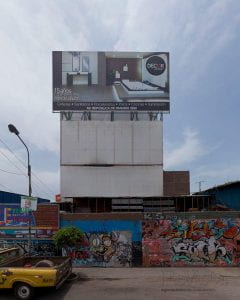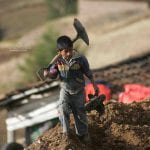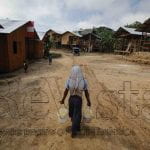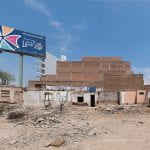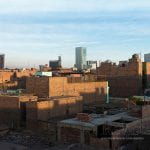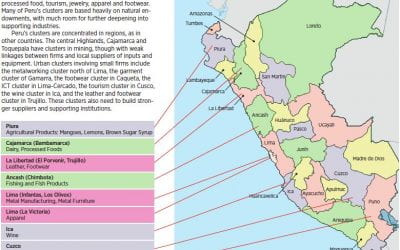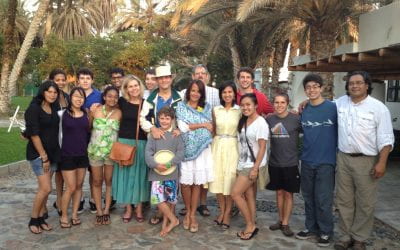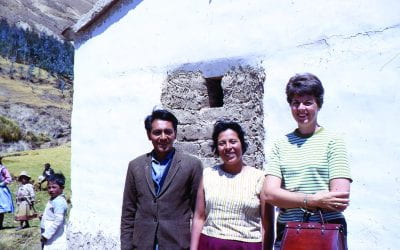First Take: Paradoxes of Peruvian Democracy
Political Bust Amid Economic Boom?
- Students pledge allegiance. Photo by Martin Alvarado, Ojos Propios.
- “Patriomóvil” honoring Perú’s flag. Photo by Samuel Chambi, Centro de la Imagen.
- A farmer in his fields. Photo by Martín Alvarado, Ojos Propios.
- Download original image A young woman with intricate designs on her face. Photo by Martín Alvarado.
- Download original image Young man works the fields. Photo by Martín Alvarado.
- An Afro-Peruvian man at El Carmen. Image by Eduardo Hirose, Centro de la Imagen.
- A housing development with an ad for a swanky shopping mall. Image by Eduardo Hirose, Centro de la Imagen.
- A view of sprawling Lima. Image by Eduardo Hirose, Centro de la Imagen.
For many observers, Peru has become one of Latin America’s great success stories. The country has boasted one of the fastest growing economies in the hemisphere for the last decade, with the economy nearly doubling in size. GDP growth averaged 6.5 percent a year between 2002 and 2012—the highest ten-year growth rate in Peruvian history. Incomes soared, and the poverty rate was cut in half, falling from more than 50 percent to just 26 percent. In material terms, then, Peruvians are far better off today than they were a decade ago.
Yet Peruvians remain deeply dissatisfied. This disaffection is manifested in presidential approval ratings. Whereas in most democracies public opinion corresponds closely with the state of the economy, in Peru presidential approval ratings consistently plummeted during the 2000s, even as growth soared. Thus, although Alejandro Toledo (2001-2006) had spearheaded opposition to Alberto Fujimori’s authoritarian regime and as president oversaw Peru’s remarkable economic recovery, his approval rating fell into single digits in 2004 and remained below 20 percent for most of his presidency. Toledo’s successor, Alan García (2006-2011), fared little better. Despite annual growth rates of nearly 10 percent, García’s approval rating hovered between 20 and 30 percent for most his presidency. Not only did García’s APRA party fail to even run a presidential candidate in 2011, but the election was won by Ollanta Humala, an outsider who had spent much of the decade developing a Chavista-style anti-system appeal. Now much more moderate, Humala presided over steady economic growth, but he, too, plummeted in the polls, falling to 22 percent in mid-2014.
Indeed, Peruvian presidents are the most unpopular in Latin America. According to the annual Latinobarometer survey, Peruvian governments had an average approval rating of just 26.5 percent during the 2002-2011 economic boom—a figure unparalleled in the region. By contrast, presidential approval during this period averaged 46.5 percent in Ecuador, 49.5 percent in Bolivia, 52.3 percent in Mexico, 52.5 percent in Argentina, 58.7 percent in Chile, 63.2 percent in Brazil and 65.6 percent in Colombia.
But Peruvians’ disaffection extends beyond the government of the day. Public trust in the country’s democratic institutions is among the lowest in Latin America. According to the 2010 Latinobarometer survey, only 14 percent of Peruvians trust Congress—the lowest level in Latin America and less than half the regional average (34 percent). Only 15 percent of Peruvians trust the judiciary—again, dead last in Latin America and less than half the regional average (32 percent). Only 25 percent of Peruvians say they trust their government, compared to 48 percent of Colombians, 55 percent of Brazilians and 58 percent of Chileans. Finally, only 28 percent of Peruvians say they are satisfied with their democracy, compared to 39 percent of Colombians, 49 percent of Argentines, Brazilians, and Ecuadorians and 56 percent of Chileans.
What explains the persistence of widespread public discontent in post-Fujimori Peru, even in the face of macroeconomic growth and soaring incomes? Two factors are worth highlighting. One is state weakness. Where state institutions—including national and local public bureaucracies, the police and the judiciary, public schools and health clinics, social service agencies, and regulatory agencies—do not function well, governments tend to perform poorly. In the absence of minimally effective state institutions, even well-intentioned elected governments routinely fail to deliver the (public) goods. Security, justice, education and other basic services continue to be under-provided, resulting in widespread perceptions of government corruption, unfairness, ineffectiveness and neglect. This is a major source of public discontent. Where such perceptions persist, across successive governments, public trust in democratic institutions is likely to erode. Voters conclude that “all parties are the same,” that “all politicians are corrupt” or that no one in the political elite represents them.
By virtually any measure, the Peruvian state is among the weakest in Latin America. The state’s tax capacity has also historically been low, and its limited regulatory capacity has long manifested itself in a sprawling urban informal sector. State weakness is especially pronounced in the provinces. The post-colonial elite limited its state-building efforts to Lima and the coast, leaving rural governance in the hands of landowners. Landowners remained the primary guarantor of rural social order into the 20th century, and subsequent state-building efforts, such as that of the leftist military government led by General Juan Velasco (1968-75), were largely unsuccessful. Although Velasco’s land reform destroyed the rural oligarchy, its failure to replace the old social order with minimally effective state institutions created a vacuum of authority in many parts of the highlands, which permitted the rise of the Shining Path guerrillas.
The Peruvian state nearly disintegrated in the 1980s amid a brutal insurgency and a devastating economic collapse. Although the Fujimori government restored a minimum of order in the 1990s, state institutions remain remarkably weak. Throughout much of the country, police and judicial authorities are often absent; schools, health clinics and state bureaucracies are barely operative, and local officials are widely viewed as corrupt or ineffective. According to a 2006 report published by the Inter-American Development Bank, Peru’s “bureaucratic functional capacity” ranked near the bottom in Latin America, below Bolivia, Guatemala and Nicaragua.
Problems of state weakness are not necessarily ameliorated by economic growth. Rising incomes do not enhance public security, make state bureaucracies more effective or improve the quality of public services. Indeed, even in a context of growing prosperity, an ineffective state can have major impact on people’s everyday lives. As a Fujimorista congressional candidate told me after the 2011 election, “Do you want to know why people [in my district] voted for Humala? Because they step outside their homes and things are booming. People drive by in new cars. Huge shopping malls are popping up everywhere. But their lives are still miserable. Why? Well, the street isn’t paved and their kids have lung problems because of the dust. Their kids get sick and miss school because there is no potable water or sewage. And the public school is barely operational anyway. Plus, there is no security, so they are afraid every time they leave their houses.”
Thus, Peru’s economic boom has had little discernible impact on the quality of the state. According to the 2011 Latinobarometer survey, only 23 percent of Peruvians believe the state has done something to benefit them or their families, compared to 44 percent of Argentines and 51 percent of Uruguayans. That year, Latinobarometer constructed an index of public satisfaction with state services that ranged from 1 (lowest satisfaction) to 10 (highest satisfaction). Peru’s score of 3.9 ranked dead last in Latin America (the regional average was 5.1).
In sum, state weakness brings ineffective governance, and ineffective governance generates discontent, which, if persistent, may erode citizens’ trust in democratic institutions.
A second factor behind public discontent in Peru may be the failures of successive Peruvian governments to invest in social policy. During the 2000s, as governments throughout Latin America dramatically expanded health, education, pensions and anti-poverty programs, Peruvian governments have been downright miserly. According to the Economic Commission on Latin America and the Caribbean (ECLAC), Peruvian social spending constitutes about 8 percent of GDP, which is barely half the Latin American average (14 percent) and is considerably lower than Mexico (13 percent), Colombia (14 percent), Chile (15 percent), Argentina (24 percent) and Brazil (26 percent). In 2009, Peru spent $229 per capita on social policy, compared to $401 per capita in Colombia, $889 per capita in Mexico, $945 per capita in Chile, and $1,165 per capita in Brazil.
Peruvian public spending on education (2.6 percent of GDP in 2009) is barely half the Latin American average (5.1 percent of GDP) and ranks well below Colombia (3.1 percent), Mexico (4.1 percent), Chile (4.3 percent), Brazil (5.7 percent) and Argentina (6 percent). Likewise, Peru’s public expenditure on healthcare constituted 1.2 percent of GDP in 2009, compared to 1.9 percent in Colombia, 2.8 percent in Mexico, 3.7 percent in Chile, 5 percent in Brazil and 5.3 percent in Argentina.
Investment in anti-poverty programs has also been minimal. Peru’s public expenditure on conditional cash transfers (CCTs) constituted .14 percent of GDP in 2010, compared to .39 percent in Colombia, .45 percent in Uruguay, .47 percent in Brazil, .51 percent in Mexico and 1.17 percent in Ecuador. Consequently, Peru’s primary CCT program, Juntos, reaches far fewer families than do similar programs elsewhere in Latin America. Whereas CCTs in Argentina, Chile, Colombia, Mexico, Brazil and Ecuador covered between 46 percent and 100 percent of the poor in 2010, Juntos covered a mere 21 percent of the Peruvian poor.
Although Ollanta Humala made “social inclusion” the centerpiece of his 2011 presidential campaign and launched several new anti-poverty initiatives upon taking office, social spending increases have, in fact, been quite modest. In fact, the Peruvian government remains one of the most miserly in the world. The conservative Heritage Foundation’s annual Index of Economic Freedom scores countries on 10 dimensions of “economic freedom,” with 0 being the most statist and 100 being the most free market-oriented. In the area of “government spending,” with lower spending yielding a higher score, Peru’s score of 89.1 in 2014 is not only the highest in South America (Chile receives a score of 83.8) but nearly matches those of Hong Kong (89.7) and Singapore (91.1), which the Heritage Foundation ranks as the two most free market economies in the world.
Why do Peruvian governments spend so little on social policy? The answer lies, in part, in the devastating economic collapse of the 1980s, which generated an elite consensus around strict fiscal and monetary orthodoxy. The orthodox consensus has been reinforced by the weakness of left-wing political forces and the virtual absence of national-level popular mobilization. It may also be reinforced by the weakness of politicians more generally. The collapse of political parties in the 1990s decimated Peru’s political class and gave rise to a generation of amateur politicians. As Peruvian political scientist Alberto Vergara has argued, amateur politicians without parties are simply no match for the experienced corps of neoliberal technocrats who have been operating within the state since the 1990s.
Whatever the cause, ultra-tight purse strings have exacerbated longstanding problems of democratic representation. Because politicians campaign on the center-left but govern on the center-right, Peruvians see little connection between what they vote for and how they are governed. A near-total disconnect between elections and the governments they produce reinforces the perception that “all politicians are alike,” or that they are all corrupt.
The post-Fujimori regime has now survived for 13 years—longer than any other democracy in Peruvian history. But it has survived largely by default. Peruvians remain deeply dissatisfied with their governments, even in the very best of economic times. When the boom ends, as booms inevitably do, democracy may again be in for a challenge.
Fall 2014, Volume XIV, Number 1
Steven Levitsky is Professor of Government at Harvard University. He specializes in comparative and Latin American politics, with a focus on political parties, authoritarianism, and democratization. He also writes a regular column in the Peruvian newspaper La República.
Related Articles
Towards a National Value Proposition
Peru has been one of the most remarkable economic growth stories of the last decade, both compared to its own historic record and to its peers in Latin America and beyond. A combination of sound macroeconomic policies since the mid-1990s and a benevolent international economic environment with growing demand for Peru’s natural resources has allowed the country to prosper.
A Taste of Lima
Each one of us has a grandmother or mother, grandfather or father whose dish—humble or elaborate—transports us back in time or space, surrounds us with people, places, images, languages, and even fragrances of the past. The dish—or the memory of the dish—evokes a smile, or perhaps a tear, and generally seems inimitable by those who share the memory.
Seeking Progress in Twentieth-Century Peru
The year was 1993. My wife Barbara and I had just arrived in Lima, with the intention of working there for two or three years. I had a job in a USAID project, while my wife was part of a World Bank planning group in the Ministry of Education. Peru was just recovering from staggering blows, both economic and political.

